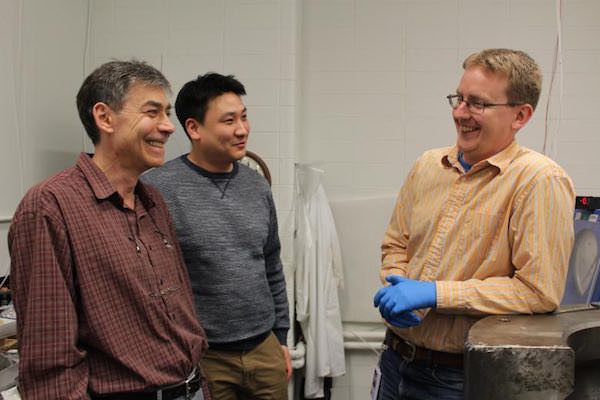
[Image above] U.S. Naval Research Laboratory scientists (left to right) Boris Feygelson, Heonjuene Ryou, and James Wollmershauser, who worked together to push the boundaries of nanocystalline ceramics. Credit: U.S. Naval Research Laboratory
Researchers at the U.S. Naval Research Laboratory (Washington, D.C.) have hit a new low.
“A few years ago, NRL was the first to show that if you decrease the grain size of ceramics to tens of nanometers, the hardness and strength increase,” James Wollmershauser, a materials research engineer in NRL’s Materials Science and Technology Division, says in a recent NRL news release. “Our current work takes this much further. We decreased the grain size of fully dense ceramics to record breaking single digits, and analyzed the elasticity, hardness, energy dissipation, and fracture behavior in ceramics with a wide range of nanosize grains.”
I wrote about that previous research on Ceramic Tech Today four years ago. The key to the NRL team’s big development, both then and now, is a technique that allows the scientists to sinter nanocrystalline ceramics with record-small grain sizes.
Appropriately called environmentally controlled pressure assisted sintering (EC-PAS), the nanosintering technique combines complete environmental control with pressure-assisted sintering to densify ceramic nanoparticles. In EC-PAS, the high surface energy of clean nanoparticles combined with pressure sintering increases the driving force for densification.
This allows the sintering to be performed at lower temperatures—EC-PAS can be done at ~640–850ºC, whereas pressure sintering of magnesium aluminate spinel is typically done at 1500–1600ºC. Because higher temperatures drive grain growth, the ability to densify at lower temperatures allows EC-PAS to fabricate dense ceramics with very little grain growth.
While the NRL scientists’ previous research achieved grain sizes as small as 28 nm (and disproved a previous assumption that the Hall-Petch relationship breaks down at such small grain sizes), the new research hits a record low—grains just 3.6 nm wide.

NRL postdoctoral fellow Heonjune Ryou operates laboratory machinery to fabricate nanocrystalline ceramics. Credit: U.S. Naval Research Laboratory
The NRL team’s analysis of these nanocrystalline ceramics shows that such small grains afford the materials unique abilities—their super small grains can better dissipate mechanical energy than larger grain sizes.
Although the scientists aren’t yet sure what mechanism is behind these effects, their work does indicate that it’s not strain rate sensitive, eliminating creep or diffusion-based mechanisms.
However, the research does present some evidence that the unique microstructure of nanocrystalline ceramics is driving the change in strain accommodation—decreasing density with smaller grain sizes (<8 nm) correlates with a swiftly increasing volume fraction of grain boundary triple junctions.
Nonetheless, regardless of the mechanism, the NRL research ultimately shows that smaller grain sizes better dissipate mechanical energy in these nanocrystalline ceramics.
That’s important for the ability of materials like ceramic armor to perform their function—in that application, the ability to dissipate mechanical energy can mean a matter of life and death for someone wearing ceramic armor. Plus, stronger ceramics also allow less material to be used, enabling lighter weight armor that doesn’t sacrifice strength.
In addition to existing applications, better ability to control grain size further opens up capabilities to engineer materials be design—the idea that adjusting control of fabrication parameters can design ceramics with tailored properties and characteristics for a specific application.
“When we were doing this research we started to develop a vision for other applications. We realized that we could approach this research in nanocrystalline materials with a much broader perspective,” Boris Feygelson, materials research engineer in NRL’s Electronics Science and Technology Division who is leading the nanosintering effort, says in the release. “EC-PAS opens the door to explore limits of many phenomena in nanostructured materials. Armor materials is just the beginning. So, suffice it to say… stay tuned.”
The research, published in ACS Nano, is “Below the Hall–Petch limit in nanocrystalline ceramics” (DOI: 10.1021/acsnano.7b07380).
Author
April Gocha
CTT Categories
- Manufacturing
- Material Innovations
- Nanomaterials
- Thermal management


